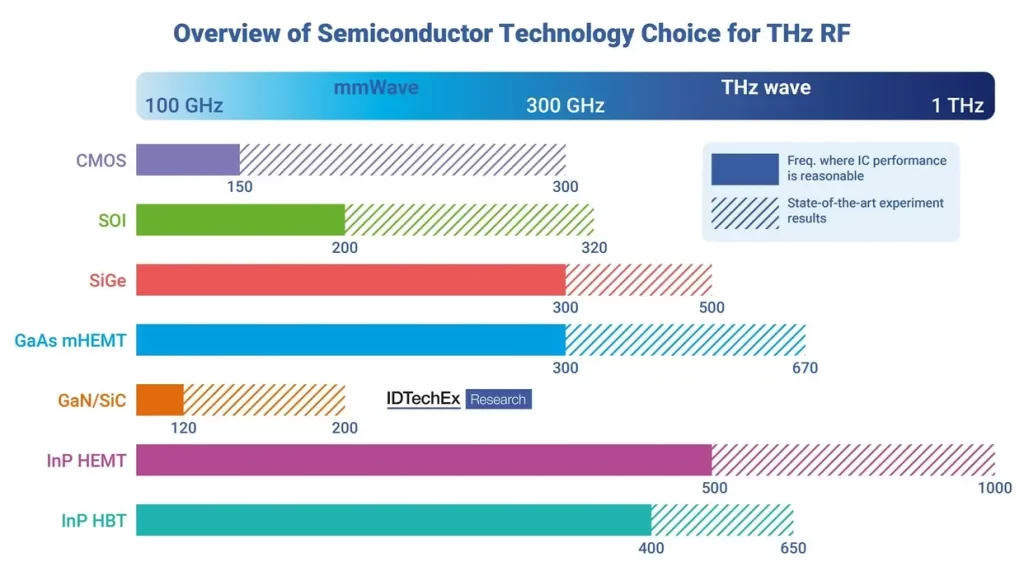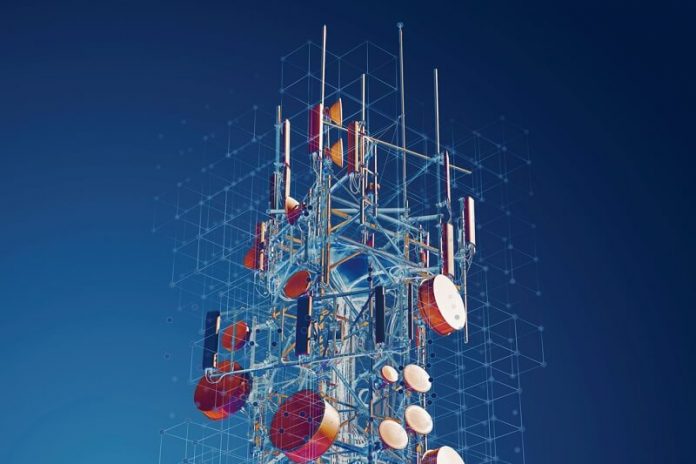Every decade, a new telecom generation emerges, with 5G currently being commercialized, offering faster data rates, low latency, and enhanced reliability. 6G is characterized by Tbps data rates, microsecond latency, and extensive network dependability. Operating in the THz spectrum, it extends to applications beyond connectivity, encompassing energy harvesting, sensing, and more.
Frequency Considerations
Let’s start by delving into the fundamental aspect of frequency bands. In the realm of 5G, the frequency band assigned includes the sub-6 GHz spectrum (ranging from 3.5 to 6 GHz) and the millimeter wave (mmWave) band (stretching from 24 to 40 GHz). As we shift our focus to 6G, the spectrum encompasses a range of frequencies. The candidates include the 7 to 20 GHz frequency band, followed by the W-band (75 to 110 GHz), the D-band (110 to 175 GHz), segments spanning 275 to 300 GHz, and extending into the terahertz (THz) range (0.3 to 10 THz).
Incorporating the 7 to 20 GHz bands is strategic, driven by the demand for coverage that can support mobile applications and facilitate “on the go” applications for diverse 6G use cases. The W and D bands, spanning 75 to 175 GHz, hold significance not only for 6G access but also for networks like Xhaul, encompassing Fronthaul and backhaul services. Solutions that effectively serve both these services are under consideration.
As of September 2022, global spectrum allocations haven’t extended beyond 275 GHz. However, the 275 to 450 GHz range has been earmarked for implementing land mobile and fixed service applications alongside radio astronomy, Earth exploration-satellite services, and space research services, spanning from 275 to 1,000 GHz.
An overarching depiction of the 6G spectrum deployment strategy. It’s worth noting that while the THz band technically spans from 300 GHz to 10 THz, professionals in the telecommunications field have categorized applications beyond 100 GHz as THz communications.
The key challenge in 6G
6G promises substantial advantages, most notably the potential for leveraging expansive bandwidth (GHz range) that can support peak data flow in the terabits per second (Tbps) range, all while maintaining microsecond-level latency. However, despite the immense potential, the utilization of such high-frequency spectra is not without its challenges.
The key challenges in 6G are very short signal propagation range (cm range for above 100 GHz frequency) and Line-of-Sight obstacles.
Terahertz signals face severe limitations in how far they can travel due to substantial absorption in the air. This makes addressing signal decaying and establishing strong communication over reasonable distances a top priority for 6G. Likewise, the higher frequency nature of terahertz signals makes them highly sensitive to obstacles in their direct path, such as buildings, trees, and other objects. Handling these two challenges is crucial, especially in busy urban areas, where ensuring consistent connectivity despite barriers is a significant undertaking.
To overcome this issue, improving the link budget of a communication device becomes essential to enhance signal propagation. Higher power is needed for higher link budget. The final power output results from both the antenna gain and the power amplifier (PA) gain. In the following two sections, we will discuss how to address this challenge from both antenna and power amplifier design aspects.
Technological approaches
Choices of semiconductor:
Selecting the appropriate semiconductor for 6G communication involves a careful evaluation of fundamental link budget boundaries, encompassing power amplifiers (PA) and low-noise amplifiers (LNA). These two act as key indicators, establishing the upper limit of attainable link performance. Notably, in a comprehensive transceiver design, further compromises are essential to account for parameters like linearity, signal combination, power efficiency, spectral efficacy, form factor, and cost considerations.
To identify the most suitable semiconductor technology, a critical criterion is transistor performance, necessitating a minimum of three times and ideally more than five times the carrier frequency. As a result, achieving effective performance in the sub-THz spectrum (100 GHz – 300 GHz) relies on transistors operating between 500 GHz and 1 THz. Currently, only SiGe and InP have demonstrated such performance and have a roadmap to pass beyond 1 THz.

Semiconductor technology choices operating at above 100 GHz spectrum. For operations up to 150 GHz, CMOS proves adequate to support devices requiring short-range communication capabilities. However, for longer-range distances, the incorporation of alternative semiconductors such as SiGe or III-V, especially for power amplification, may be necessary. As frequencies climb beyond 200 GHz, a heterogeneous approach entails coupling CMOS for logic functions with III-V transistors for low-noise and power amplification tasks will be the way to go. Within the 200 GHz to 500 GHz range, the SiGe BiCMOS technology emerges as an ideal compromise, adeptly balancing performance, affordability, and integration ease. Meanwhile, InP technology presents itself as a top candidate for terahertz applications, particularly for scenarios prioritizing performance over cost considerations.
Antenna design:
In the context of evolving form factors for advanced communication systems, a significant challenge emerges concerning antenna spacing and power dynamics, particularly in the transition from 5G to 6G. Due to lower output power capabilities of power amplifiers at sub-THz range, higher noise of receivers, and increased loss in the radio channel for unity gain antenna element, the antenna gain required at 100 – 300 GHz is at least double than in 5G NR FR2 bands in order to provide decent link range (>50 dBi vs 30 dBi).
In the lower mmWave band of 5G NR, larger antenna dimensions permit the integration of multiple antenna elements within a single IC or dual-feed configurations, facilitating the creation of RF-controlled phased arrays.
However, as the frequency spectrum shifts into the upper mmWave band (100 – 300 GHz), the minimal spacing between antenna elements drastically reduces, limiting the potential area for both antenna components and associated electronics within a transceiver to a range of 0.25 – 2.25 mm² per RF route. This disparity between antenna and electronics dimensions, notably in the upper mmWave frequencies, introduces challenges in maintaining a harmonious form factor between these critical components, thereby constraining the feasible size of antenna arrays.
The power aspect adds another layer of complexity; while CMOS or SiGe BiCMOS devices could provide sufficient transmit power, the incorporation of external power amplifiers (PA) for enhanced output necessitates significantly more space than the antenna, potentially impeding viable antenna design variations.
Additionally, factors like complex mechanics, thermal management, and integration of antenna elements with RF circuitry on the same chip surface, grow in prominence with the rise in frequency. As communication systems progress, these multifaceted issues underscore the importance of careful consideration and innovative solutions to effectively navigate the evolving landscape of form factors, power requirements, and associated challenges in antenna integration and design.
6G Roadmap and outlook
The development of 6G technology has been rapidly advancing since its inception. As early as 2017, Huawei embarked on its 6G research, signaling the industry’s anticipation for the next-generation wireless technology. Since 2019, key milestones have been achieved on multiple fronts. The US Federal Communications Commission (FCC) opened up Terahertz (THz) frequencies for experimental studies and trials. China also formally initiated its 6G research, underscoring its commitment to technological leadership. Global collaboration and consortiums gained traction, with the US Next G Alliance, Japan’s B5G consortium, and the European Union’s Hexa-X project all contributing to a regional collaborative atmosphere of research and innovation, demonstrating a global interest in pushing the boundaries of communication capabilities.
Meanwhile, pioneering initiatives by companies from infrastructure suppliers to telecom operators showcased key strides in hardware innovation and continue to pump investment into 6G R&D, underlining their dedication to shaping the future of wireless communication.
Advancements were also seen in satellite-based services and wireless connections. China launched its first 6G satellite, expanding the scope of possibilities beyond terrestrial communication. Apple launched SOS service via satellite in iPhone14 models. Starlink has had worldwide connection apart from the poles since August 2021.
According to IDTechEx, the gradual introduction of 6G technology is likely to begin around 2028, with official commercialization anticipated by 2030. The standardization process, led by 3GPP, will be vital for ensuring the compatibility and adoption of this innovative technology, and it is set to commence in 2026.
In conclusion, the road to 6G has been shaped by continuous dedicated research, collaborations spanning public and private sectors, and important technological progress. While 6G’s transformative potential is clear, ongoing efforts to overcome hardware and software challenges, coupled with identifying essential applications, are vital for its success.

